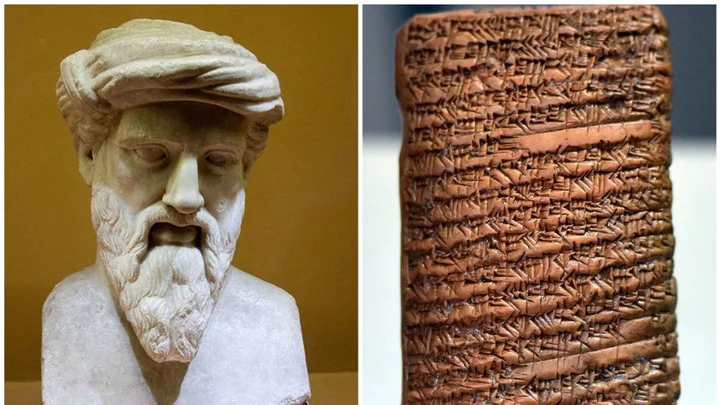
Pythagoras' theorem found on tablet that is 1,000 years older than Pythagoras himself
For many of us, the mere words “Pythagoras’s theorem” are enough to revive pencil-smudged exercise books and desperate attempts to copy classmates’ work. And yet, it turns out the name that has struck dread in countless school kids over the centuries is about as accurate as this writer’s attempts at geometry. Because although it is assumed that the legendary Greek philosopher Pythagoras himself was to thank for the equation a2 + b2 = c2, it turns out it was being used some 1,000 years before his time. Archaeologists have found the equation on a Babylonian tablet which was used for teaching back in 1770 BCE – centuries before Pythagoras’s birth in around 570 BC, as IFL Science notes. Another earlier tablet, from between 1800 and 1600 BC, even features a square with labelled triangles inside. Translations of the markings, which followed the base 60 counting system used by ancient Babylonians, prove that these mathematicians were familiar with Pythagorean theorem (although, obviously, they didn’t call it that) as well as other advanced mathematical principles. In a paper dedicated to the discovery, data scientist Bruce Ratner wrote: "The conclusion is inescapable. The Babylonians knew the relation between the length of the diagonal of a square and its side: d=square root of 2. "This was probably the first number known to be irrational. However, this in turn means that they were familiar with the Pythagorean Theorem – or, at the very least, with its special case for the diagonal of a square [...] more than a thousand years before the great sage for whom it was named." And yet, one key problem remains unsolved: why did the equation become equated with the famous Greek? Well, most likely because Pythagoras wanted it to be. In his paper, Ratner points out that although the Ionian icon is widely considered the first bonafide mathematician, little is known about his specific mathematical achievements. Unlike his successors, he didn’t write any books that we know of, so there’s no written evidence of his work. However, we do have proof that he founded a semi-religious school called the Semicircle of Pythagoras, which followed a strict code of secrecy. As Ratner explained: “Pythagorean knowledge was passed on from one generation to the next by word of mouth, as writing material was scarce. Moreover, out of respect for their leader, many of the discoveries made by the Pythagoreans were attributed to Pythagoras himself. “Consequently, of Pythagoras’ actual work nothing is known. On the other hand, his school practiced collectivism, making it hard to distinguish between the work of Pythagoras and that of his followers. “Therefore, the true discovery of a particular Pythagorean result may never be known.” Still, he stressed, even though Pythagoras wasn’t the brains behind the most famous formula in maths, he does deserve a little credit for putting it on the map. Sign up for our free Indy100 weekly newsletter Have your say in our news democracy. Click the upvote icon at the top of the page to help raise this article through the indy100 rankings.
2023-10-03 19:50

Scientists have discovered a disturbing link between milk tea and depression
Bad news for milk tea drinkers, as the beverage - which comes in different forms such as bubble tea - has some disturbing links to depression, according to a new study. Milk tea is widely consumed worldwide, but it has become particularly popular among young people in China over recent years. While many of us buy the drink as a sweet treat or pick-me-up, researchers from Tsinghua University and the Central University of Finance and Economics in China investigated whether milk tea addiction is a thing. After 5,281 university students in Beijing were surveyed as part of the research published in the Journal of Affective Disorders, they found that milk tea addiction does exist and also spotted connections between this issue with anxiety and depression. Researchers noted the "tremendous growth" the beverage has had with youth as well as their findings from the study. "Our findings highlighted that milk tea consumption might lead to addiction, and it is associated with depression, anxiety, and suicidal ideation," they wrote in the paper. Nearly half of the students surveyed said they had at least one cup of milk tea on a weekly basis, while a scale of addiction was used to understand the symptoms such as cravings, immoderation and how this affects daily life. Given that milk tea includes both caffeine and extra sugar, the effects of these ingredients cause worry - with low moods and social isolation as examples. "The results indicate that milk tea consumption might lead to addiction symptoms, including frequency, dependence/craving, intention to stop, unable to stop, tolerance, and guilty feelings," the paper read. Milk tea addiction has been compared to social media and drugs in terms of how damaging it can be, particularly when used to try and regulate emotions. However, a large study would be needed over a longer period of time to gain further understanding of this. To conclude, researchers want further regulation and safeguarding against both the physical and mental symptoms possibly connected to drinking milk tea, for example addiction, depression and obesity. "Current findings can assist policymakers in developing regulations such as restricting advertising, providing psycho-education, establishing food hygiene standards for such a prosperous youth-dominant consumption industry while protecting their mental health," they stated. Sign up to our free Indy100 weekly newsletter Have your say in our news democracy. Click the upvote icon at the top of the page to help raise this article through the indy100 rankings.
2023-10-02 22:15
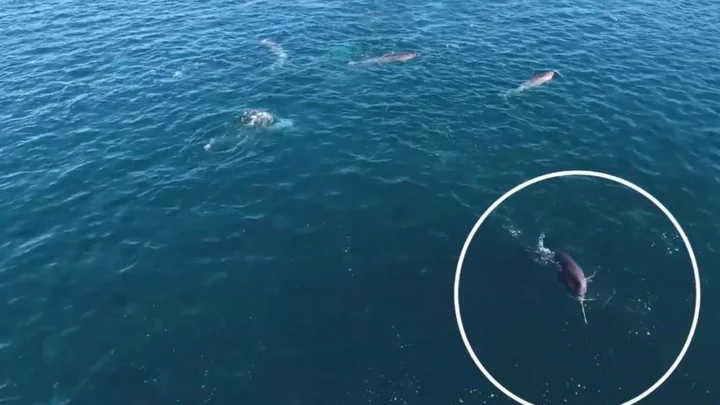
There's a sinister reason why you never see narwhals in aquariums
Narwhals are among the most elusive creatures in the ocean, with their long, spiralling tusks giving them an almost mythological quality. And whilst many people would pay good money to see these unicorns of the sea in the flesh, they are notably absent from the world’s aquariums. The reason for this is both dark and mysterious, since there have only been two attempts to keep the toothed whales in captivity. Both of these ended in tragedy and the general acceptance that narwhals simply don’t belong in our sealife centres. The legendary porpoises, which are related to belugas and orcas, are found in Arctic coastal waters and rivers. They have two teeth and, in males, the more prominent of these grows into the swordlike tusk which can be up to 10 feet long, according to National Geographic. Back in 1969, Coney Island’s New York Aquarium becoming the first-ever centre to put a narwhal on display. According to IFL Science, the aquarium became home to a young calf called Umiak, whose name referred to the canoe used to hunt the species in the High Arctic. It was captured by members of the Inuit community who said that it followed their canoe back to camp after they killed its mother for meat. Umiak was put in a tank alongside a female “white whale” (most likely a beluga), who acted as its stepmother. And although staff reportedly fed vast quantities of milk mixed with chopped clams to keep it happy, they weren’t able to keep it healthy. Less than a year after Umiak arrived at the centre, the orphaned narwhal died of pneumonia, as reported by The New York Times at the time. Still, the animal’s swift and tragic demise didn’t stop Canada’s Vancouver Aquarium from attempting the same feat in 1970. The aquarium had been gearing up to host a narwhal since 1968, when its director, Murray Newman, hoped that bringing narwhals to the city could generate interest in the species and help with its conservation, IFL Science reports. After two unsuccessful attempts to capture one of the whales themselves, Newman and his team were forced to buy a young male from a community of Inuit hunters based in Grise Fiord on Canada’s Ellesmere Island. The animal was reportedly called Keela Luguk – a phonetic spelling of the word “qilalugaq”, which means “narwhal” in some Inuktitut dialects. Within a week of Keela Luguk’s arrival at Vancouver Aquarium in August 1970, the centre had caught two female narwhals and three calves, which were then added to his tank. However, in less than a month, the three calves had died. And by November, the two females were also gone. As public outrage mounted, the mayor of Vancouver himself called for Keela Luguk to be returned to the wild. But Newman would not succumb to their pressure and, eventually, on 26 December that same year, the young whale was reported to have died too. It’s not known exactly why the narwhals fared so dismally in captivity, particularly given that the species’s closest relative, the beluga, can survive a number of years, or even decades, in aquarium facilities. However, the porpoises are known to be exceptionally sensitive animals, with studies finding that they are so affected by human-made noises that even the sound of a ship sailing near their habitat is enough to radically impact their behaviour. Fortunately, aquariums seem to have got the memo, and narwhals have largely been left to continue their lives as fabled enigmas of the sea. Sign up for our free Indy100 weekly newsletter Have your say in our news democracy. Click the upvote icon at the top of the page to help raise this article through the indy100 rankings.
2023-10-02 19:20
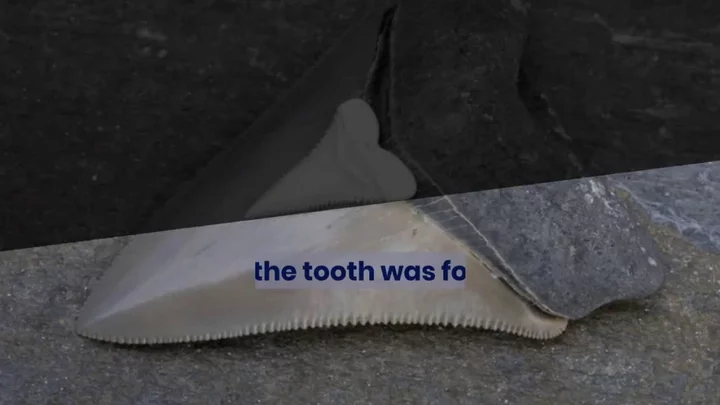
Divers discover Megalodon teeth in flooded cave in Mexico
Divers in Mexico have discovered Megalodon teeth in a flooded inland cave and the findings have confirmed scientific beliefs. Megalodons were absolutely gigantic prehistoric sharks that reached sizes of up to 50 feet long. They dominated the oceans before going extinct around 3.6 million years ago. Scientists are interested in studying fossils of the huge sea creature, with the animal's teeth proving the most abundant type of fossil to be found today. Teeth fossils were found in Mexico by speleologist (cave specialist) and photographer Kay Nicte Vilchis Zapata and fellow speleologist Erick Sosa Rodriguez while diving in a newly discovered sinkhole in Cholul in 2019. The cenote is 400 meters long and 28 meters deep and located inside were fifteen teeth fossils from various shark species. They also discovered human remains and a vertebrae fossil that potentially belongs to an ancient species. A total of 13 of the 15 teeth fossils belonged to three different species of shark – one being the megalodon (Carcharocles megalodon), while the other two species were the mackerel shark (Isurus oxyrinchus) and the sawshark (Pristiophoridae). Zapata told local media at the time: “We were looking at the wall and suddenly I saw a little something, I went closer and I saw that it was a tooth, that was the first and apparently it belonged to a sawshark.” Experts believe the geological timescale of the megalodon teeth lies anywhere between 2.5 million to 5 million years old. Speleologist Sosa Rodriguez said: “It is just proof of what scientists have already studied and written about; what kind of wildlife lived here millions of years ago when this was part of the sea.” Scientists have suggested that the megalodon’s warm body temperature may have been the reason for its extinction. There is some thought that the megalodon was able to maintain a body temperature around 7 degrees centigrade warmer than the water around it, but ultimately this may have been its downfall. Randy Flores, a UCLA doctoral student and fellow of the Centre for Diverse Leadership in Science, explained: “Maintaining an energy level that would allow for megalodon’s elevated body temperature would require a voracious appetite that may not have been sustainable in a time of changing marine ecosystem balances when it may have even had to compete against newcomers such as the great white shark.” Sign up to our free Indy100 weekly newsletter Have your say in our news democracy. Click the upvote icon at the top of the page to help raise this article through the indy100 rankings.
2023-10-02 17:56

What's the Appalachian Trail? The iconic footpath featured in today's Google Doodle
As many of us face the drudgery of a Monday morning commute and a day holed up at work, it’s almost painful to think of beautiful, far-off lands and breathtaking views. And yet, this is what Google is inviting us to do with today’s interactive Doodle. Head to the search engine’s homepage and you’ll find a slideshow in the style of an illustrated scrapbook, teaching readers all about the Appalachian Trail. The iconic trail is the longest hiking-only footpath in the world, spanning more than 14 US states and 2,190 miles, as it meanders across dense forests, rushing rivers, and soaring mountains. And if you're wondering why the tech company has decided to pay tribute to the famous landmark today, it's because on 2 October 1968, America’s National Trails System Act established the Appalachian Trail as one of the country’s first National Scenic Trails. Hiking the full length of the path can take between five and seven months to complete and requires careful planning. And yet, as Google’s slideshow points out, around 3,000 people attempt this staggering feat each year, with a total of three million people visiting the trail annually. The route has served walking enthusiasts for nearly 100 years, having been completed in 1937. It was first proposed by conservationist Benton MacKaye in 1921, with his original plan calling for a stretch of several self-sustaining agricultural camps along the way, Google notes in its blurb for the Doodle. Then 10 years later, a hiker named Earl Shaffer became the first person to make it from one end to the other. Since then, more than 14,000 people have joined him in completing the trek. Perhaps inevitably for such a legendary trail, it has engendered a number of unique traditions. These include being given a “trail name” by fellow hikers and eating two litres of ice cream at the route’s mid-point. However, the trail’s oldest and most important tradition is to leave it just as you found it so that everyone can enjoy the same natural beauty. Sign up for our free Indy100 weekly newsletter Have your say in our news democracy. Click the upvote icon at the top of the page to help raise this article through the indy100 rankings.
2023-10-02 16:19
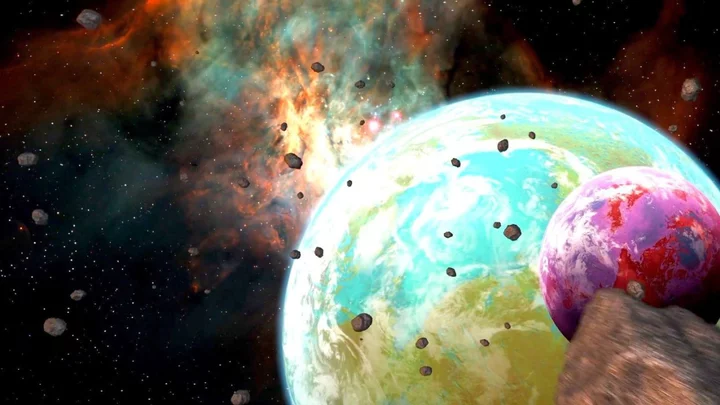
Scientists now say finding alien life in the universe is 'only a matter of time'
Scientists are optimistic about the possibility of finding life on other planets. Nasa's James Webb Space Telescope (JWST) found a possible sign of a gas that, on Earth, is produced by simple marine organisms. It was detected this month in the atmosphere of a planet named K2-18b, which is 120 light years away. The planet is in what astronomers call ''the Goldilocks zone' - the right distance away from its star for the surface temperature to be neither too hot nor too cold, but just right for there to be liquid water, which is essential to support life. The team expects to know in a year's time whether the hints are confirmed or have gone away. "We live in an infinite Universe, with infinite stars and planets. And it's been obvious to many of us that we can't be the only intelligent life out there," Prof Catherine Heymans, Scotland's Astronomer Royal told the BBC. "We now have the technology and the capability to answer the question of whether we are alone in the cosmos." Prof Nikku Madhusudhan of the Institute of Astronomy at Cambridge University, who led the study, told the BBC that if the hints are confirmed "it would radically change the way we think about the search for life". "If we find signs of life on the very first planet we study, it will raise the possibility that life is common in the Universe." He predicted that within five years there will be "a major transformation" in our understanding of life in the Universe. If his team don't find life signs on K2-18b, they have 10 more Goldilocks planets on their list to study - and possibly many more after that. Even finding nothing would "provide important insights into the possibility of life on such planets", he said. Meanwhile there are other separate projects all looking for signs of life in the universe. Pretty exciting. Sign up to our free Indy100 weekly newsletter Have your say in our news democracy. Click the upvote icon at the top of the page to help raise this article through the indy100 rankings.
2023-09-30 23:16

Has Facebook changed its blue logo?
Facebook is known for its recognisable 'f' logo using the colours light navy blue and white - however, people can't help but notice something different. Some have noticed that once logged into their account there has been a slight tweak to the blue colour they have been familiar with in recent years. The new blue announced by the social media platform is richer, bold and darker in a move which is "Redefining Facebook’s brand identity." “We’re excited to launch the first phase of a refreshed identity system for Facebook, with a focus on fostering effortless, self-initiated exploration and connection across every touchpoint," the announcement read. There were three "key drivers" in regards to the brand design update which include: "Elevate the most iconic elements of our brand to create a distinctive, refreshed Facebook." The second is to "Unify how the Facebook brand comes to life across product-to-marketing experiences." On the topic of blue tone change, this came from wanting to "create an expansive set of colours — anchored in our core blue — that is comprehensive and vibrant, and also designed to be more accessible for people." Of course, Facebook users couldn't help but notice the colour change and took to social media to question if their eyes were deceiving them. Elsewhere, a Mark Zuckerberg product has been deemed the 'cringiest AI of all time'. Sign up to our free Indy100 weekly newsletter Have your say in our news democracy. Click the upvote icon at the top of the page to help raise this article through the indy100 rankings.
2023-09-29 22:23

Mark Zuckerberg's latest AI product has been deemed 'cringiest AI of all time'
Mark Zuckerberg, CEO of Meta, revealed its latest AI product containing quite a few familiar faces, but people are unimpressed. On Wednesday at Meta's Connect conference, Zuckerberg unveiled Meta's new AI assistant at its headquarters in Menlo Park, California. The digital assistant has drawn comparisons to ChatGPT, where the program generates in-depth and detailed answers to text queries. What makes it different from other AI assistants, however, is that the assistants have faces of celebrities such as Paris Hilton, Kendall Jenner, and Mr. Beast. The various celebrities partnered with Meta to introduce its "cast of characters". For example, Billie - portrayed by Kendall Jenner - is described as your "No-BS, ride-or-die companion". Roy Choi, a Korean-American chef, plays Max, a "seasoned sous chef for culinary tips and tricks". Each character has also been given their own profile on Instagram and Facebook. Zuckerberg posted the announcement in a video to his Instagram and Facebook profiles, involving him and his family displaying their poor acting skills, as well as Kendall Jenner, Tom Brady, Charli D'Amelio, Snoop Dogg, and Dwayne Wade as their AI assistant characters. But whilst Zuckerberg seemed impressed with the new product, most viewers did not share the same sentiments. Host of Corporate Gossip podcast Becca Platsky posted her reaction to the announcement video, calling it the "cringiest AI of all time". "There's something this product gets so wrong about the way people interact with influencers," Platsky says. "And one thing is influencer snark. That drives a lot of engagement to real life influencers, but nobody's gonna snark on a robot!" She also said, "I'm also not sure how many people are going to want to give Kendall Jenner more money for doing less work." Comments under Platsky's TikTok overwhelmingly agreed. Some called it "embarrassing" whilst another user said it felt "like an SNL skit." "I feel like they think we care about celebrities more than we actually do," commented another user. The criticism didn't stop there though, with many commenting under Zuckerberg's announcement letting him now their thoughts. One user called it "depressing" and said "adding more AI to talk to on [an] everyday basis, this is just loneliness amplified." Another gave Zuckerberg the advice to "fire everyone in your staff that failed to tell you how monumentally stupid this video is." Adding, "who the hell needs to chat to AI friends that look like celebrities?" Sign up to our free Indy100 weekly newsletter Have your say in our news democracy. Click the upvote icon at the top of the page to help raise this article through the indy100 rankings.
2023-09-29 19:16
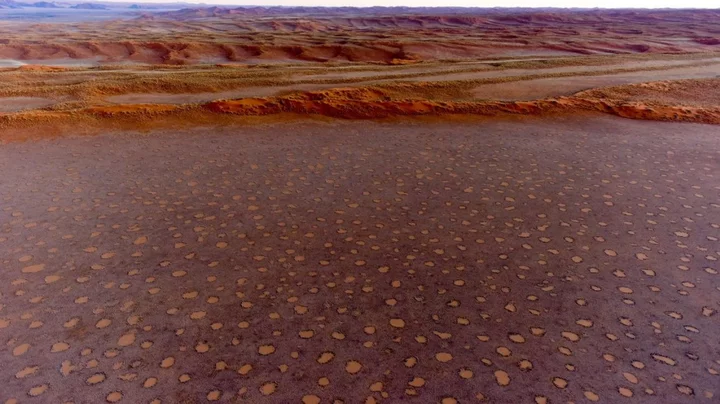
Mysterious fairy circles are increasing across the world and scientists are baffled
A natural phenomenon consisting of polka-dot-style formations has been cropping up around the world, and scientists are baffled as to why. The circular-shaped patches of ground have been seen in deserts in Australia and Namibia but now experts believe they are more widespread than originally thought. Known as “fairy circles”, there are now 263 known sites across the globe where they can be found, according to new research published in the journal Proceedings of the National Academy of Sciences (PNAS). They have been documented in 15 countries, across three continents, including the Sahel region of Africa, Madagascar, and in Middle-West Asia. And yet, despite the spread of these anomalies, scientists are still none the wiser about how they actually form. A team led by environmental scientist Emilio Guirado, of the University of Alicante in Spain, explained in their paper on the "intriguing" phenomenon: “We conducted a global and systematic assessment of fairy circle-like vegetation patterns and discovered hundreds of [fairy-circle]-like locations on three continents. “Our study provides insights into the ecology and biogeography of these fascinating vegetation patterns and the first atlas of their global distribution.” The mysterious circles appear in desert regions and can be as wide as 12 metres (39 feet) in diameter. They are almost always spaced out and rarely connect or overlap with one another. Several theories have been put forward as to what causes them, including, tiny insects, termites, and plant toxins. But, none have been accompanied by any significant evidence and some have been debunked completely. One significant factor limiting their study is they are often found in places that are difficult to access and are inhospitable. Locating the 263 different sites of “fairy circles” involved analysing high-resolution satellite imagery. Guirado and his team wrote in their paper: “[The sites] include those already identified in Namibia and Western Australia, as well as areas never described before, including the Sahel, Western Sahara, Horn of Africa, Madagascar, Southwest Asia, or Central and Southwest Australia. “By doing so, our study provides a global atlas of areas showing FC-like vegetation patterns and expands the known existence of this vegetation type to new countries and continents.” The team hopes that locating new sites will enable them to find common traits that may point towards their cause. Sign up to our free Indy100 weekly newsletter Have your say in our news democracy. Click the upvote icon at the top of the page to help raise this article through the indy100 rankings.
2023-09-29 16:28

Scientists confirm that the most iconic black hole in the universe is spinning, in major new discovery
Scientists have confirmed that the first black hole to ever be captured on camera is spinning in a major new discovery. The famous doughnut-shaped M87* black hole, 6.5 billion times more massive than the sun, first drew people’s attention in 2019 for becoming the first void to be pictured. Now, it has been confirmed that the M87* black hole is spinning, but experts have yet to determine just how fast. The announcement was made on 27 September. M87* has been observed for the last two decades via a network of radio telescopes. It is located in the Messier 87 (M87) galaxy, which is around 55 million light-years away from Earth in the Virgo constellation. The instruments monitoring the black hole have observed a powerful jet of radiation and particles being expelled from its poles. According to research, the relativistic jets appeared to be on a kind of pendulum that swings every 11 years, observed over decades. Experts believe this is caused by interactions between gravitational interactions between the black hole and the material making up the disk around it. They say this provides “unequivocal evidence” that the black hole is spinning. Cui Yuzhu, a researcher at Zhejiang Lab in China and the study’s lead author explained in a statement: “We are thrilled by this significant finding,” adding, “Since the misalignment between the black hole and the disk is relatively small and the precession period is around 11 years, accumulating high-resolution data tracing M87’s structure over two decades and thorough analysis are essential to obtain this achievement.” Their findings matched with computer simulations, confirming that the jets emitting from the black hole change direction by around 10 degrees every 11 years. Sign up to our free Indy100 weekly newsletter Have your say in our news democracy. Click the upvote icon at the top of the page to help raise this article through the indy100 rankings.
2023-09-28 20:25

Time-lapse that took 20 years to make shows legendary stellar explosion
Scientists have spent 20 years putting together time-lapse footage offering a stunning window into the past. Two decades of data taken from NASA’s Chandra X-ray Observatory were used by astronomers to create a video of a stellar eruption that actually occurred 180 years ago. Observations from Chandra, taken in 1999, 2003, 2009, 2014 and 2020 were all used, in combination with data from ESA’s XMM-Newton spacecraft. With the combined data, experts were able to capture the stellar explosion, known as Eta Carinae. Eta Carinae is a famous star system containing two large stars, one of which is around 90 times larger than the Sun, while the other is around 30 times as large. The “Great Eruption” from Eta Carinae is believed to be the result of the merging of two stars that were originally part of a three-star system. Eta Carinae Time-Lapse, Chandra X-ray Observatory www.youtube.com It first took place in the mid-19th century and the aftermath is still continuing to be observed today. New footage shows how the explosion has expanded into space with staggering speeds of up to 4.5 million miles per hour. In a statement, NASA officials explained: “During this event, Eta Carinae ejected between 10 and 45 times the mass of the sun. This material became a dense pair of spherical clouds of gas, now called the Homunculus Nebula, on opposite sides of the two stars.” The Homunculus Nebula is the blue cloud visible in the video, while the growing bright orange ring shows how X-ray emissions have grown and expanded over time. “The new movie of Chandra, plus a deep, summed image generated by adding the data together, reveal important hints about Eta Carinae’s volatile history,” the statement read. “This includes the rapid expansion of the ring, and a previously-unknown faint shell of X-rays outside it.” Sign up to our free Indy100 weekly newsletter Have your say in our news democracy. Click the upvote icon at the top of the page to help raise this article through the indy100 rankings.
2023-09-28 18:53

People are just learning Google's original name – and thanking god that it was changed
A world without Google would almost be akin to a world without water or air. Indeed, the internet behemoth’s power is so great that it’s even become its own verb. And sure, there are other search engines, but when have you ever heard someone say: “Let me just Bing that”? Yet, it turns out the iconic tech company could have had a very different fate had it stuck to its original name. That’s right, Google hasn’t always been Google. And at its inception back in 1996, it had a somewhat more risqué title. It was called… BackRub. Yep, BackRub. According to Standford University computer scientist David Koller, who wrote about the brand’s genesis back in 2004, founders Larry Page and Sergey Brin came up with the search engine's first name as a nod to its analysis of the web’s “back links”. However, a year after BackRub was born, Page and his officemates – including fellow graduate students Sean Anderson, Tamara Munzner, and Lucas Pereira – discussed a number of possible alternatives to the massage-evoking moniker. According to Koller, the final, fateful brainstorming session occurred one day in September of that year. “Sean and Larry were in their office, using the whiteboard, trying to think up a good name - something that related to the indexing of an immense amount of data,” he recalled. “Sean verbally suggested the word ‘googolplex,’, and Larry responded verbally with the shortened form, ‘googol’ (both words refer to specific large numbers). “ Anderson then searched the Internet domain name registry database to see if the newly suggested name was still available to use. But, since “Sean is not an infallible speller”, “he made the mistake of searching for the name spelt as ‘google.com,’ which he found to be available,” Koller continued. “Larry liked the name, and within hours he took the step of registering the name ‘google.com’ for himself and Sergey.” And the rest, as they say, is history. Sill, 25 years on from that simple domain name registration that would go on to change the world, people have shared their bewilderment that “BackRub” could have become a household name. “I could die without knowing that this was Google's old name,” one X/Twitter user commented. “What were they smoking back in 90s??” asked another. Meanwhile, a third responded with what we’re all now thinking: “Tbh I need a backrub.” At least the tech titans can now give themselves a pat on the back for a job well done with “Google”. Sign up for our free Indy100 weekly newsletter Have your say in our news democracy. Click the upvote icon at the top of the page to help raise this article through the indy100 rankings.
2023-09-28 16:51
